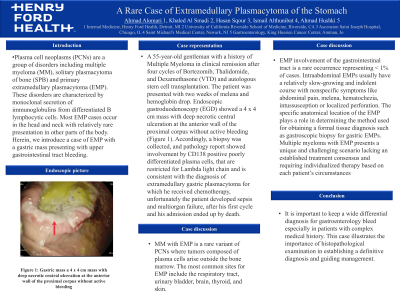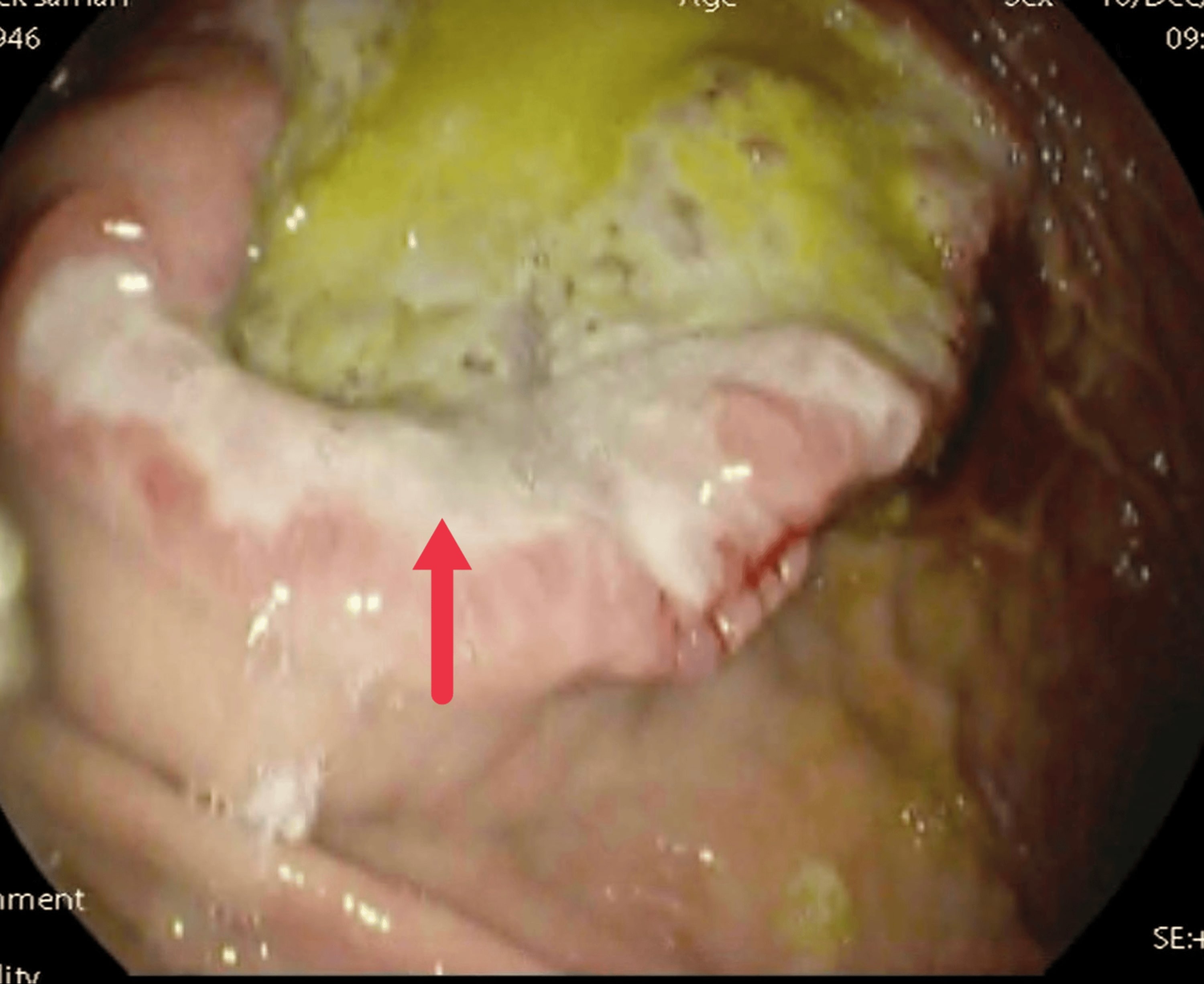Monday Poster Session
Category: Stomach
P3380 - A Rare Case of Extramedullary Plasmacytoma of the Stomach
Monday, October 28, 2024
10:30 AM - 4:00 PM ET
Location: Exhibit Hall E

Has Audio

Ahmad Alomari, MD
Henry Ford Hospital
Detroit, MI
Presenting Author(s)
Ahmad Alomari, MD1, Khaled Al Smadi, MD2, Hasan Sqour, MD3, Ismail Althunibat, MD4, Ahmad Hushki, MBBCh5
1Henry Ford Hospital, Detroit, MI; 2University of California Riverside School of Medicine, San Bernardino, CA; 3Ascension Saint Joseph Hospital, Chicago, IL; 4Saint Michael's Medical Center, Newark, NJ; 5King Hussein Cancer Center, Jubeiha, 'Amman, Jordan
Introduction: Plasma cell neoplasms (PCNs) are a group of disorders including multiple myeloma (MM), solitary plasmacytoma of bone (SPB) and primary extramedullary plasmacytoma (EMP). These disorders are characterized by monoclonal secretion of immunoglobulins from differentiated B lymphocytic cells. Most EMP cases occur in the head and neck with relatively rare presentation in other parts of the body. Herein, we introduce a case of EMP with a gastric mass presenting with upper gastrointestinal tract bleeding.
Case Description/Methods: A 55-year-old gentleman with a history of Multiple Myeloma in clinical remission after four cycles of Bortezomib, Thalidomide, and Dexamethasone (VTD) and autologous stem cell transplantation. The patient was presented with two weeks of melena and hemoglobin drop. Endoscopic gastroduodenoscopy (EGD) showed a 4 x 4 cm mass with deep necrotic central ulceration at the anterior wall of the proximal corpus without active bleeding (Figure 1). Accordingly, a biopsy was collected, and pathology report showed involvement by CD138 positive poorly differentiated plasma cells, that are restricted for Lambda light chain and is consistent with the diagnosis of extramedullary gastric plasmacytoma for which he received chemotherapy, unfortunately the patient developed sepsis and multiorgan failure, after his first cycle and his admission ended up by death.
Discussion: MM with EMP is a rare variant of PCNs where tumors composed of plasma cells arise outside the bone marrow. The most common sites for EMP include the respiratory tract, urinary bladder, brain, thyroid, and skin. EMP involvement of the gastrointestinal tract is indeed a rare occurrence representing < 1% of MM cases. Intraabdominal EMPs usually have a relatively slow-growing and indolent course with nonspecific symptoms like abdominal pain, melena, hematochezia, intussusception or localized perforation. The specific anatomical location of the EMP plays a role in determining the method used for obtaining a formal tissue diagnosis such as gastroscopic biopsy for gastric EMPs. Multiple myeloma with EMP presents a unique and challenging scenario lacking an established treatment consensus and requiring individualized therapy based on each patient’s circumstances. It is important to keep a wide differential diagnosis for gastroenterology bleed especially in patients with complex medical history. This case illustrates the importance of histopathological examination in establishing a definitive diagnosis and guiding management.

Disclosures:
Ahmad Alomari, MD1, Khaled Al Smadi, MD2, Hasan Sqour, MD3, Ismail Althunibat, MD4, Ahmad Hushki, MBBCh5. P3380 - A Rare Case of Extramedullary Plasmacytoma of the Stomach, ACG 2024 Annual Scientific Meeting Abstracts. Philadelphia, PA: American College of Gastroenterology.
1Henry Ford Hospital, Detroit, MI; 2University of California Riverside School of Medicine, San Bernardino, CA; 3Ascension Saint Joseph Hospital, Chicago, IL; 4Saint Michael's Medical Center, Newark, NJ; 5King Hussein Cancer Center, Jubeiha, 'Amman, Jordan
Introduction: Plasma cell neoplasms (PCNs) are a group of disorders including multiple myeloma (MM), solitary plasmacytoma of bone (SPB) and primary extramedullary plasmacytoma (EMP). These disorders are characterized by monoclonal secretion of immunoglobulins from differentiated B lymphocytic cells. Most EMP cases occur in the head and neck with relatively rare presentation in other parts of the body. Herein, we introduce a case of EMP with a gastric mass presenting with upper gastrointestinal tract bleeding.
Case Description/Methods: A 55-year-old gentleman with a history of Multiple Myeloma in clinical remission after four cycles of Bortezomib, Thalidomide, and Dexamethasone (VTD) and autologous stem cell transplantation. The patient was presented with two weeks of melena and hemoglobin drop. Endoscopic gastroduodenoscopy (EGD) showed a 4 x 4 cm mass with deep necrotic central ulceration at the anterior wall of the proximal corpus without active bleeding (Figure 1). Accordingly, a biopsy was collected, and pathology report showed involvement by CD138 positive poorly differentiated plasma cells, that are restricted for Lambda light chain and is consistent with the diagnosis of extramedullary gastric plasmacytoma for which he received chemotherapy, unfortunately the patient developed sepsis and multiorgan failure, after his first cycle and his admission ended up by death.
Discussion: MM with EMP is a rare variant of PCNs where tumors composed of plasma cells arise outside the bone marrow. The most common sites for EMP include the respiratory tract, urinary bladder, brain, thyroid, and skin. EMP involvement of the gastrointestinal tract is indeed a rare occurrence representing < 1% of MM cases. Intraabdominal EMPs usually have a relatively slow-growing and indolent course with nonspecific symptoms like abdominal pain, melena, hematochezia, intussusception or localized perforation. The specific anatomical location of the EMP plays a role in determining the method used for obtaining a formal tissue diagnosis such as gastroscopic biopsy for gastric EMPs. Multiple myeloma with EMP presents a unique and challenging scenario lacking an established treatment consensus and requiring individualized therapy based on each patient’s circumstances. It is important to keep a wide differential diagnosis for gastroenterology bleed especially in patients with complex medical history. This case illustrates the importance of histopathological examination in establishing a definitive diagnosis and guiding management.

Figure: Figure 1: Gastric mass
a 4 x 4 cm mass with deep necrotic central ulceration at the anterior wall of the proximal corpus without active bleeding
a 4 x 4 cm mass with deep necrotic central ulceration at the anterior wall of the proximal corpus without active bleeding
Disclosures:
Ahmad Alomari indicated no relevant financial relationships.
Khaled Al Smadi indicated no relevant financial relationships.
Hasan Sqour indicated no relevant financial relationships.
Ismail Althunibat indicated no relevant financial relationships.
Ahmad Hushki indicated no relevant financial relationships.
Ahmad Alomari, MD1, Khaled Al Smadi, MD2, Hasan Sqour, MD3, Ismail Althunibat, MD4, Ahmad Hushki, MBBCh5. P3380 - A Rare Case of Extramedullary Plasmacytoma of the Stomach, ACG 2024 Annual Scientific Meeting Abstracts. Philadelphia, PA: American College of Gastroenterology.
